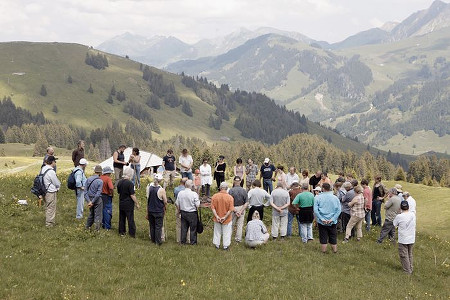Since many members of our SevenPonds team have tapped into their ethnic roots for this column, I’m long overdue to contribute. I’m half Swiss, so I’m familiar with Switzerland’s more progressive burial practices (and cremation scattering.)
Let’s face it, the Swiss are known as independent thinkers and champions of pragmatism. Switzerland has the highest cremation rate in Europe at 80%, compared to the U.S at 35%. Why does this not surprise me? I spent my childhood at Seven Ponds lakes in Michigan (the information for this very site), within a community of 28 Swiss families called the “Swiss Farms.” I was exposed to enough of the unorthodox Swiss practices to expect this of my (half) homeland.
What still remains of their traditional burial practices is, in fact, not so traditional. The cemeteries are some of the most beautiful in the world and have a very picturesque quality. But what’s really extraordinary is how immaculate the burial plots are with their profuse bursts of flowers. Naturally, I’m familiar with the deep love of flowers the Swiss have. This love goes in hand with their anal-retentiveness using flowers to create a picture perfect landscape.
“What still remains of their traditional burial practices is, in fact, not so traditional”
What’s most unusual is the pragmatic relationship the Swiss have with death. No grave is more than 25 years-old, except for a few old family plots. This practice carefully regulates the precious use of land in what is such a small country. When the 25th year arrives, the graves are dug up to make room for new residents, relocating the bones to a mass gravesite. It’s a cultural norm that may be difficult for some people to swallow — but not for the Swiss.
On the other hand, one must acknowledge the fact that cremation ashes are not regulated after they are handed over to a family member. The Swiss are free to keep, bury, or scatter cremation ashes as they wish (even in the Alps).
Switzerland also has unique “forest cemeteries” where one buries ashes at the root of a tree (the tree can be rented by the family for 30 years.) It’s a lovely practice, as one could say it creates a “living gravestone.”
The Swiss are very ecologically-minded and these forests must be open to all visitors; no urns are allowed to be buried, nor are any marked grave stones, crosses or decorations permitted anywhere. Much like our green burial cemeteries, the land is intended to remain in its beautiful naturalized state. This makes perfect sense to me. I was raised with the rule of no soap, toothpaste or oils allowed in the spring-fed Seven Ponds lakes. It’s the sensibility of having as little environmental impact as possible on the land you love and respect.
“It’s a most lovely practice, as one could say it creates a “living gravestone.””
The Swiss love rules, organization and (of course) a perfect scenic landscape. Is there anything as lovely as having an idyllic, green place to sit and reflect on one’s memories of a loved one? It is thanks to the intersection of unique, detail-orientated Swiss cultural traits that allows for this reality.
Our team members who have contributed their cultural death practices in the past:
- Our former Blogger, Dana Sitar who hails from the Midwest, offers her family’s savory traditional Funeral Potato recipe.
- Our former Marketing Assistant, Hedieh Haghighi lets us into her world of Iranian loving funeral practices.
- Huyen Do, my go-to girl, inspired our Blogger MaryFrances with her stories of on-going memorial parties typical of her Vietnamese Funeral Customs.

 Swiss Pragmatism Extends into Death
Swiss Pragmatism Extends into Death





 “Hand to Earth” by Andy Goldsworthy
“Hand to Earth” by Andy Goldsworthy
 Trans Remembrance Project Provides a Community of Grieving
Trans Remembrance Project Provides a Community of Grieving
 Caring for a Dying Loved One? Be Gentle With Yourself.
Caring for a Dying Loved One? Be Gentle With Yourself.














